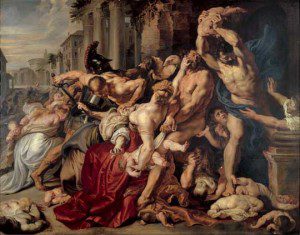There’s an interesting back-and-forth between Patheos bloggers James McGrath and Tony Jones regarding one part of the Christmas story, Herod’s massacre of the infants in Matthew’s Gospel.
This story follows the visit of the magi or wise men, who had visited Herod with their news that they had seen signs in the heavens marking the birth of a new king. Herod, the current king, was not as pleased by this news as the magi. After they head home without telling him the identity of this royal child, Matthew tells us that Herod took brutal action to preserve his power.
The story is told in Matthew 2:16-18:
When Herod saw that he had been tricked by the wise men, he was infuriated, and he sent and killed all the children in and around Bethlehem who were two years old or under, according to the time that he had learned from the wise men. Then was fulfilled what had been spoken through the prophet Jeremiah:
“A voice was heard in Ramah,
wailing and loud lamentation,
Rachel weeping for her children;
she refused to be consoled, because they are no more.”
Those evocative words from Jeremiah have led many to cite this story in recent days, as the Christmas story and the massacre of innocents have again converged.
That prompted McGrath’s first post: “Why I’m Glad Matthew’s Infancy Narrative Isn’t Literally True.” He says that this story, which isn’t found in the other Gospels, probably never really happened:
We have no evidence that young children in Bethlehem were in fact slaughtered as per Matthew’s story. More likely, Matthew is working in details from the story of Moses in order to highlight the similarity between Moses and Jesus.
And that’s a good thing, McGrath argues, since the story Matthew tells is problematic. Specifically, he says, it seems horrible that the wise men and Joseph were warned by God to flee from Herod, but no such warning was given to all the other families in Bethlehem, allowing them to save their children too:
When we seek to work a divine plan or miraculous interventions into the stories, we never end up depicting God as just, but rather as unjust.
 Tony Jones disagrees, arguing that James McGrath is wrong and that Herod really did massacre the innocents. Hence the title of his response: “James McGrath Is Wrong: Herod Really Did Massacre the Innocents.”
Tony Jones disagrees, arguing that James McGrath is wrong and that Herod really did massacre the innocents. Hence the title of his response: “James McGrath Is Wrong: Herod Really Did Massacre the Innocents.”
McGrath’s first post didn’t really make a case that this story is not historical, but just began with the assumption that it isn’t. Jones’ response, likewise, doesn’t offer a case for why the story is historical, but just begins with the assumption that it is, warning against mythologizing horrific stories in an attempt to “let God off the hook.”
Neither of these posts argues for or against the historicity of the story on historical grounds. McGrath and Jones are really discussing, instead, the implications of the factual truth or untruth of the story Matthew tells.
McGrath’s follow-up post — “Am I Wrong About the Massacre of the Innocents?” — points in the direction of a more substantial case against reading this story as a historical account of actual events, but I wished he’d pointed us toward a fuller argument elsewhere, as what he provides there is still sketched a bit broadly:
The truth is that we do not know that innocent infants were killed. We have no record in any other source about this event. That doesn’t mean we can be certain it never occurred.
… Tony is legitimately concerned that historical people not be turned into fables. But we must also have the reverse concern, that fictional accounts not be misconstrued as factual ones.
In this case, although it is possible that Herod killing a few children in a small village simply didn’t get mentioned by any other source, we cannot know that. What we do know is that we have two accounts of the infancy of Jesus which are incompatible in their details. And we know that most ancient infancy stories were mythological and symbolic ways of emphasizing a person’s importance without much historical information. And we know that Matthew was interested in highlighting similarities and differences between Jesus and Moses, and the irony of the poor reception Jesus got in Israel. And so a historian justifiably suspects that the infancy narrative is a literary creation intended to introduce major themes which will be to the fore in the rest of the Gospel – the story of an individual about whom it was believed that, if he was so significant, his birth must have been remarkable too.
I’m out of my element here. This is McGrath’s discipline, and he’s a sharp guy. His short ebook on The Burial of Jesus offers a look at his cautious, scrupulous approach to such historical questions, and it makes me inclined to trust him.
But on the other hand, this is not a story that I had previously seen challenged. It doesn’t set off the alarm-bells that some other biblical stories do, inviting such skeptical scrutiny.
The supernatural elements are relatively subdued here — some dream visions and whatever sort of astrology the magi were using. The antagonist, Herod, is an undisputed real person from history. (I’ve personally seen several of his public works projects, and they’re still impressive 2,000 years later.)
The story also seems congruent with the behavior of little puppet-kings like Herod — so much so that it’s not being recorded elsewhere doesn’t suggest anything particularly conclusive. “King Kills a Dozen Peasants in Backwater Village” would not have been front-page news in the First Century. “King Kills Peasants” was more like a weather report — something routine enough to be unremarkable.
But then we shouldn’t judge the First Century too harshly for that. Children are being killed in Bethlehem now and that doesn’t seem to make the news today either. (See also: Gaza. See also: diarrhea, which kills more infants every day than Herod did in a lifetime, and yet almost never makes the news.)
This story of Herod’s massacre is also presented as a plausible narrative. By that I mean that the text itself doesn’t cause us to question it. Matthew’s “then was fulfilled” attempt to tie the story to the words of a prophet is a bit eager-to-please, but the story of Herod’s slaughter is presented as a plausible third-person account of a public event.
Contrast that with, for example, Matthew’s account of Jesus temptation in the wilderness, which comes a few chapters later in Matthew 4:1-11. Who’s telling that story? Matthew presents it as a view-from-nowhere third-person account, but this was not a public event. Jesus was the only one there, so again, who’s telling this story? The temptation narrative itself invites scrutiny and questioning. The text itself suggests that this is a second-hand (at best) retelling of a story Jesus told to his disciples — a story that may have been more or less parabolic, more or less literal in its factual basis.
That raises questions in a way that the story of Herod and the infants had not done so for me. It simply had not occurred to me, previously, to subject that particular story to the kind of historical scrutiny that McGrath is confident it cannot withstand.
OK, then. Whether one sides with James McGrath or with Tony Jones on this question, we’re still left with one unchallenged and unchallengeable historical fact: The author of the Gospel of Matthew chose to include this story. Why?
The historical question that Jim and Tony are debating only partly addresses the question of why the story was included. Yes, one contributing factor might be that the massacre of the infants actually happened. Or it might be that the author of Matthew mistakenly believed that the massacre actually happened. But that belief only suggest that this story was a candidate for inclusion in Matthew’s Gospel. An evangelist is not a biographer, bound to include an account of everything that took place. The author of Matthew chose to include this story. The authors of Mark, Luke and John did not. What accounts for that choice?
McGrath’s contention that it stems from Matthew’s desire to highlight similarities between Jesus and Moses has a lot to support it. Matthew was big on drawing such parallels and “fulfillments” of prophecy (sometimes stretching quite creatively to do so). The Herod story echoes the Pharaoh story from the life of Moses, and also provides the pretext for the Holy Family’s flight to Egypt. That gives Jesus a sojourn in Egypt, just like the patriarchs Abraham, Jacob and Moses. (I’d be wholly convinced of this if Matthew had included a story in which Joseph lied, telling everyone in Egypt that Mary was his sister.)
The motif McGrath discusses of echoes, allusions and fulfillments of prophecy is certainly something present throughout the book of Matthew, but it’s not the paramount theme of this Gospel. That theme — Matthew’s essential focus from start to finish — is Jesus’ own message of the kingdom of heaven.
And that central theme of the kingdom of heaven, I think, is what accounts for Matthew’s choice to include the story of the massacre of the infants in Bethlehem. Herod had a kingdom too, and in this story Matthew is reminding us that such worldly kingdoms are very different from the kingdom of heaven. (For a sense of Matthew’s estimation of “all the kingdoms of this world,” just look at who owns them in that story about Jesus temptation in the wilderness.)
The story of Herod’s slaughter echoes the story of Moses, but I don’t think this was mainly in order to invite us to see the similarities between Jesus and Moses. I think it was mainly in order to highlight the contrast between Jesus and Pharaoh.
So with this story — regardless of its historical reliability — I wind up back where I always wind up.
It’s about Power vs. Love; Love vs. Power. This is Jesus’ story. This is Matthew’s Gospel.
Power kills. Love wins.
One of those last two sentences is an undeniable historical fact. I hope the other one is too.












